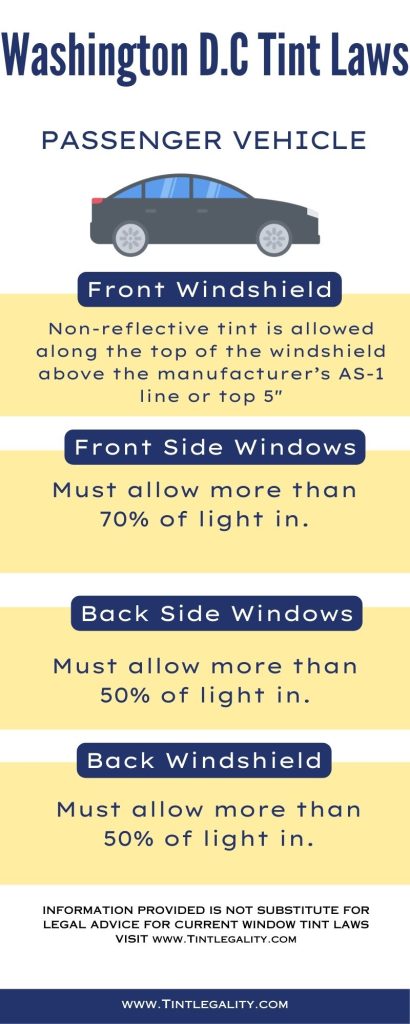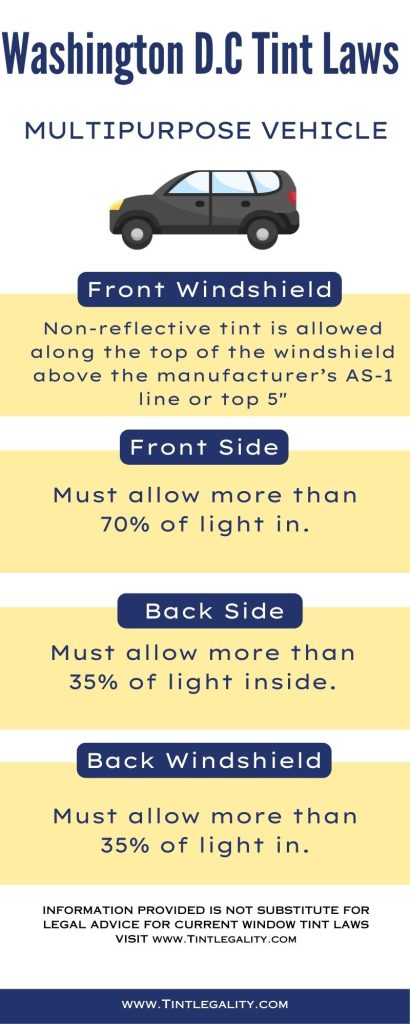Washington D.C tint laws were enacted in 1994 and have set a benchmark for car window tinting across the state.
This comprehensive guide to Washington D.C. Tint Laws will cover all the rules and regulations you need to be aware of if you’re considering tinting your car windows.
Regulations Regarding Window Tint in Washington D.C
The percentage of visible light allowed through your car windows is referred to as VLT: Visible Light Transmission.
The specific percentage allowed through your film and glass in Washington D.C differs for Sedan cars and SUV cars or vans.
| Window | Sedan | SUV and Vans |
|---|---|---|
| Windshield | Non-reflective tint above the AS-1 line | Non-reflective tint above the AS-1 line |
| Front Side Windows | Must allow 70% of light in | Must allow 70% of light in |
| Back Side Windows | Must allow 50% of light in | Must allow 35% of light in |
| Rear Window | Must allow 50% of light in | Must allow 35% of light in |
Windshield
Non-reflective tint is permitted along the top of the windshield above the manufacturer’s AS-1 line or the top 5 inches, whichever comes first.
This regulation ensures drivers’ visibility isn’t compromised while providing some protection from the sun.
Front Side Windows
The laws stipulate that the front side windows must allow 70% of light in.
This ensures ample light enters the driver’s cabin, ensuring visibility isn’t greatly reduced.
Back Side Windows
Here is where the rules vary between different types of vehicles.
In Sedans, the backside windows must allow at least 50% of light in.
However, for SUVs and vans, the law allows a darker tint, with at least 35% light required to pass through.
Rear Window
The rear window rules follow a similar pattern as the backside windows.
Sedans must allow 50% of light through, while SUVs and vans can have darker tints, permitting only 35% of light.


Additional Regulations
Apart from the basic rules based on VLT percentages, Washington D.C Tint Laws also encompass other essential factors such as window reflection and color restrictions.
Reflection
Reflective window tint helps to reflect incoming light, reducing glare and heat.
While some states have specific laws regarding reflective tints, Washington D.C doesn’t currently provide any specific laws pertaining to this.
Medical Exemptions
Washington D.C allows medical waivers for window tinting.
If you have a specific medical condition that warrants darker tints, consult with your local DMV for further info.
Color Restrictions
Washington D.C doesn’t have restrictions on tint colors.
However, it’s always best to double-check this information with your local DMV or law enforcement authorities as laws can vary slightly.
Side Mirrors
No restrictions have been stipulated regarding the tinting of side mirrors.
They are allowed to be tinted as per your preference without violating Washington D.C Tint Laws.
Exceptions to Legal Limits
Tint certificates are required in the District of Columbia.
In addition, a sticker to identify legal tinting is necessary.
This acts as evidence of the legality of your vehicle’s tinting.
Penalties for Breaking the Law
Breaking Washington D.C Tint Laws can result in hefty penalties.
The fine for non-compliance is $1000 if not rectified within five days.
Fines
First Conviction
For the first violation of the tint laws, a citation of $50 can be issued.
Second Conviction
The penalties increase with each subsequent violation.
A second offense can lead to a fine of $500.
Third Conviction
The third and subsequent convictions can cost up to $1000.
These steep fines are a deterrent to drivers who might consider violating the window tint laws.
Other Penalties
In addition to fines, non-compliance with Washington D.C. Tint Laws can also lead to additional penalties.
Non-compliance beyond five days can result in a fine of $1000.
It’s crucial to abide by the law to avoid these penalties.
Always remember, the laws and regulations may be interpreted differently depending on the county or your place of residence.
Therefore, it’s highly recommended that you double-check this information with local DMV or law enforcement authorities.
As the last update was in 2023, any changes to the Washington D.C. Tint Laws post this date may not be reflected here.
Stay compliant and enjoy a safe driving experience in the capital of the United States.
References:
https://en.wikipedia.org/wiki/Washington,_D.C.
https://code.dccouncil.gov/us/dc/council/code/sections/50-2207.02.html
https://dmv.dc.gov/service/medical-waivers-vehicle-window-tinting-restrictions